Finally, there are rodents, birds, and small reptiles. These little critters make up a vast majority of animals found in most regions. High in numbers, they are still troublesome to catch, making them extremely annoying.
In certain areas, you may be tempted to hunt large primates like gorillas or chimpanzees. Yes, the DNA in these animals is almost 98 percent identical to a human’s, and they could easily supplement your dietary needs. Yet despite their nutritional advantages, hunting great apes is not recommended. A gorilla can lift 10 times its own body weight, strength enough to rip a frail zed body to shreds. Plus, primates are capable of contracting the z-virus (see “Infecting Animals,” page 132), and who wants the competition?
Other powerful animals such as bears, elephants, and large cats should also be avoided. Refer to the Animal Avoidance Chart below.
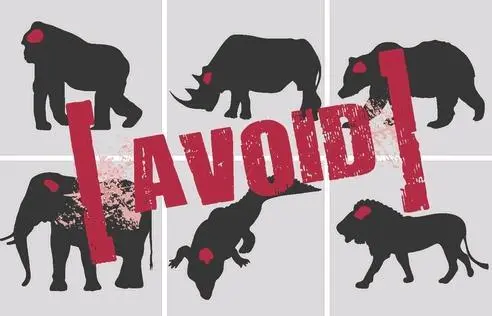
Oversized snakes have also been known to feed on zombies. If one swallows you whole, you will need to claw or bite your way out of its stomach. Even though the virus will kill the snake during the digestive process, you’ll still be stuck inside a dead snake.
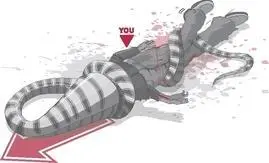
With a hunger as unrelenting as yours, you may even feel the urge to snack on other substances beyond human and animal flesh. To be on the safe side, here are some you should steer clear of:
 Flammable Liquids.Complex chemicals such as gasoline, acetone, and ethanol should never be consumed. These liquids have a high degree of flammability—they’ll turn you into a quick-light zed! Other chemicals can also lead to increased decomposition. Items labeled with the following symbols are hazardous and should be avoided.
Flammable Liquids.Complex chemicals such as gasoline, acetone, and ethanol should never be consumed. These liquids have a high degree of flammability—they’ll turn you into a quick-light zed! Other chemicals can also lead to increased decomposition. Items labeled with the following symbols are hazardous and should be avoided.

 Adhesives.If someone has thrown a sticky compound on you, do not eat it! Although it may smell like horse or cow meat, it’s not. More likely, it’s designed to bond items together, things such as zombie jaws. If ingested, your body could eventually lock up. Handling an adhesive compound can also reduce your hands’ dexterity.
Adhesives.If someone has thrown a sticky compound on you, do not eat it! Although it may smell like horse or cow meat, it’s not. More likely, it’s designed to bond items together, things such as zombie jaws. If ingested, your body could eventually lock up. Handling an adhesive compound can also reduce your hands’ dexterity.
 Polymers.Plastic materials often have sharp edges that could damage your body during consumption. These and similar nonflesh materials—metal, glass, and wood—have no nutritional benefit. Humans sometimes use these materials as armor or jewelry; eat around them.
Polymers.Plastic materials often have sharp edges that could damage your body during consumption. These and similar nonflesh materials—metal, glass, and wood—have no nutritional benefit. Humans sometimes use these materials as armor or jewelry; eat around them.
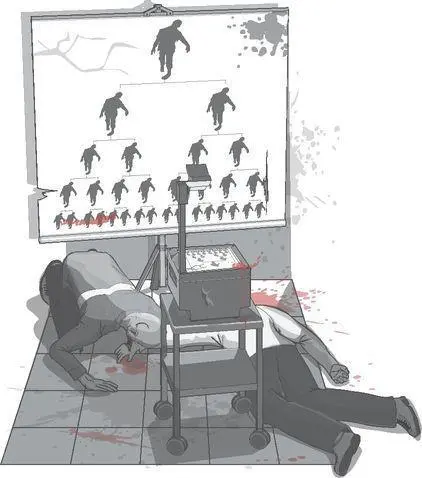
It’s not just you—all zeds are infatuated with the living. After all, they are your only physical need. Obsessed as you are with feeding, it’s not abnormal (relatively speaking) for you to turn a deaf ear to all other distractions. But while you’re eating humans, you should also give some thought to recruiting them. After all, like most predators, zombies are stronger in numbers. The more zombies you walk with, the more humans you can kill and infect—which means still more zombies, and on and on!
Amazingly, as you hunt and battle humans, something magical happens: you will automatically transfer the z-virus to your opponents. Also known as the zombie shot , it’s a simple fluid transfer that occurs during a bite or blood splatter. Once the virus is in a breather’s bloodstream, the infection is irreversible.
Though you have completed your task, the newly infected human has just been introduced to a new world. The infected’s first hours are the most critical. First, the zed-to-be must avoid being consumed. He or she will often flee from your attack, even as the early symptoms of the z-virus kick in. During the virus’s incubation period, the victim’s own bodily fluids become progressively more infectious; often an infected individual will seek shelter with other humans only to spread the virus to those in hiding. They will only welcome the stealth zed until obvious symptoms appear, at which point the infected human will be quarantined or destroyed. The good news is, the communicable seed has already been planted! Depending on the humans’ health precautions and the virulence of the z-virus strain, this common scenario can lead to an impressive outbreak.
On the flip side, as mentioned in earlier chapters, it’s very possible that a newly infected human will be so weakened by the virus that he or she is incapable of escaping your clutches. Good job—eat up! If your feeding frenzy does not damage your victim’s cranial area, and the victim was still alive before the z-virus stopped his or her heart, reanimation as a zombie is still possible. Your new zed friend likely will be a bit dismantled, and not easy on the eyes, but who among the undead is?
In other words, if you continue to properly hunt and attack, your horde should grow without any extra effort on your part. What’s better than getting something for nothing? However, if you have a rabid itch to maximize your infectious potential, this chapter is for you.
Administering an Infection
Most zombies are very reluctant to exert themselves by actively trying to infect a human. They really don’t care! Behavior like this may seem lazy, but it’s to be expected. Zombies may mob together, but they’re mostly independent. We certainly wouldn’t expect you to sacrifice a meal for the greater good of the apocalyptic pandemic! However, in every zed’s post-life comes a time when it is overwhelmed with meal choices. At that moment, when the human supply seems like more than you can handle, why not use your built-in biological weapons to weaken the resistance?
The most common way to transmit the z-virus is to expose your victim to your infected bodily fluids. The human body is covered with entry points that are vulnerable to viral penetration. The eyes, mouth, nose, and ears are all potential gateways to the human circulatory system. So are uncovered wounds anywhere on the body. More exotic infection methods, such as injection via syringe, have also been reported.

To increase your chances of infection, use one of the popular transfer methods outlined below.
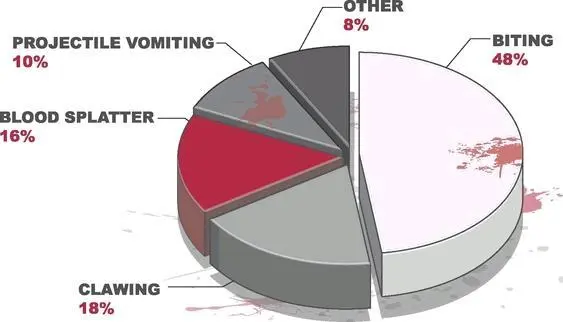
Bite It!
What did you say? “Bite me”? No problem! Forty-eight percent of all zombies were infected through a bite. As you already know, your mouth is like a versatile Swiss army knife. You can use it for attacking, holding, feeding, moaning—and infecting, too. Once your rotten grill breaks the skin of a living human, they’re contaminated. No wonder the zombie jaw is so feared by humans.
Cranial bites are the most effective, though humans will often block your attempts with their hands. A few fingers in your mouth shouldn’t stop you—think of them as appetizers. Unfortunately, if your fingerless target does make it to reanimation, the new recruit may be of little use in a fight. Without opposable thumbs, how will it ever use a melee weapon?
Читать дальше
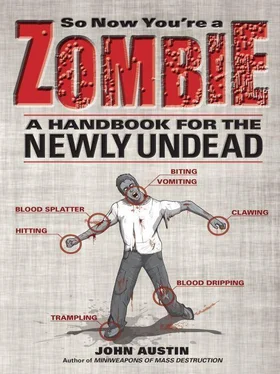


 Flammable Liquids.Complex chemicals such as gasoline, acetone, and ethanol should never be consumed. These liquids have a high degree of flammability—they’ll turn you into a quick-light zed! Other chemicals can also lead to increased decomposition. Items labeled with the following symbols are hazardous and should be avoided.
Flammable Liquids.Complex chemicals such as gasoline, acetone, and ethanol should never be consumed. These liquids have a high degree of flammability—they’ll turn you into a quick-light zed! Other chemicals can also lead to increased decomposition. Items labeled with the following symbols are hazardous and should be avoided.














